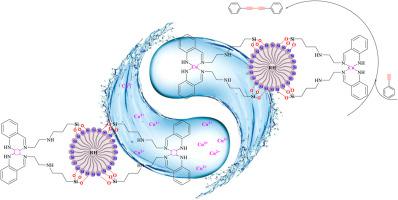Journal of Hazardous Materials ( IF 13.6 ) Pub Date : 2021-09-16 , DOI: 10.1016/j.jhazmat.2021.127203 Yue Gao 1 , Ru-Yi Zhou 2 , Lifeng Yao 3 , Weiyan Yin 4 , Jun-Xia Yu 5 , Qinyan Yue 1 , Zhiyong Xue 4 , Haifeng He 3 , Baoyu Gao 1

|
With the deepening of the concept of recycling economy and green chemistry, selective capture of Cu(II) from wastewater by biosorbent and reuse of the spent Cu(II)-loaded adsorbent are of great significance. Herein, we synthesized composite of rice husk (RH) with mesoporous silica MCM-41 (RH@MCM-41) modified by organosilane containing amino and schiff groups as functional monomer and cross-linking agent. The silica modified RH@MCM-41 was employed as supporter to fabricate copper ion-imprinted polymers as absorbents (named as RM-CIIPs) via surface ion imprinting technique. Adsorption isotherms, kinetics, selectivity and mechanism of RM-CIIPs to remove Cu(II) were investigated with respect to different adsorption condition. Furthermore, we explored the catalytic activity of spent Cu(II)-loaded adsorbent in Glaser coupling reaction. Batch adsorption studies revealed that RM-CIIP-3 prepared with functional monomer shows the best adsorption capacity (91.4 mg/g) for Cu(II), and adsorption equilibrium could be reached within 30 min. RM-CIIP-3 exhibited an excellent selectivity for capturing Cu(II) and reusability in six adsorption/desorption cycles. More importantly, the spent Cu(II)-loaded adsorbent could be used as bio-heterogeneous catalyst and afford the desired product (1,4-diphenylbutadiyne) in 99.1% yield. Our research indicates an eco-friendly systematic strategy to utilize the waste material as an adsorbent for removing heavy metals and catalyst for industry.
中文翻译:

稻壳基离子印迹聚合物的合成用于从水溶液中选择性捕获 Cu(II) 及其废料在格拉泽偶联反应中的再利用
随着循环经济和绿色化学理念的深入,利用生物吸附剂选择性捕获废水中的Cu(II)并回收利用负载Cu(II)的吸附剂具有重要意义。在此,我们合成了稻壳 (RH) 与介孔二氧化硅 MCM-41 (RH@MCM-41) 的复合材料,该复合材料由含有氨基和席夫基团的有机硅烷改性作为功能单体和交联剂。以二氧化硅改性的 RH@MCM-41 为载体,通过表面离子印迹技术制备铜离子印迹聚合物作为吸收剂(命名为 RM-CIIPs)。研究了不同吸附条件下RM-CIIPs去除Cu(II)的吸附等温线、动力学、选择性和机理。此外,我们还探讨了用过的载有 Cu(II) 的吸附剂在 Glaser 偶联反应中的催化活性。分批吸附研究表明,用功能单体制备的RM-CIIP-3对Cu(II)的吸附能力最好(91.4 mg/g),30 min内即可达到吸附平衡。RM-CIIP-3 在六个吸附/解吸循环中表现出优异的捕获 Cu(II) 的选择性和可重复使用性。更重要的是,用过的负载 Cu(II) 的吸附剂可用作生物多相催化剂,并以 99.1% 的收率提供所需的产物 (1,4-二苯基丁二炔)。我们的研究表明了一种生态友好的系统策略,即利用废料作为去除重金属的吸附剂和工业催化剂。RM-CIIP-3 在六个吸附/解吸循环中表现出优异的捕获 Cu(II) 的选择性和可重复使用性。更重要的是,用过的负载 Cu(II) 的吸附剂可用作生物多相催化剂,并以 99.1% 的收率提供所需的产物 (1,4-二苯基丁二炔)。我们的研究表明了一种生态友好的系统策略,即利用废料作为去除重金属的吸附剂和工业催化剂。RM-CIIP-3 在六个吸附/解吸循环中表现出优异的捕获 Cu(II) 的选择性和可重复使用性。更重要的是,用过的负载 Cu(II) 的吸附剂可用作生物多相催化剂,并以 99.1% 的收率提供所需的产物 (1,4-二苯基丁二炔)。我们的研究表明了一种生态友好的系统策略,即利用废料作为去除重金属的吸附剂和工业催化剂。



























 京公网安备 11010802027423号
京公网安备 11010802027423号